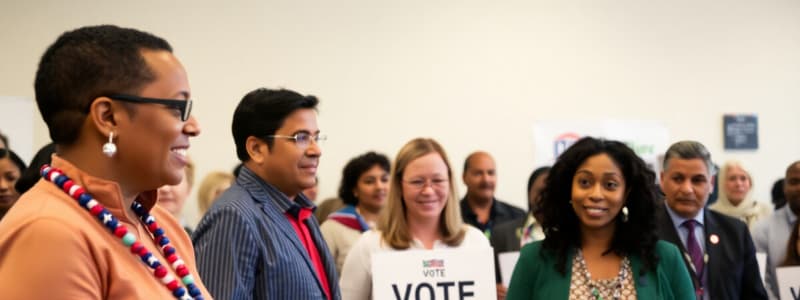Podcast
Questions and Answers
What percentage of respondents identified as Independent according to the provided data?
What percentage of respondents identified as Independent according to the provided data?
- 37% (correct)
- 27%
- 40%
- 21%
Which factor is noted as influencing voter participation in younger demographics?
Which factor is noted as influencing voter participation in younger demographics?
- Increased awareness of global warming
- Higher levels of education (correct)
- Family political beliefs
- Increased social media presence
Which group of younger voters is experiencing a higher affinity towards political parties?
Which group of younger voters is experiencing a higher affinity towards political parties?
- College professors
- Working-class voters
- Older voters
- Younger voters (correct)
What percentage of respondents identified as Not a strong Democrat?
What percentage of respondents identified as Not a strong Democrat?
How do intense preferences affect political engagement?
How do intense preferences affect political engagement?
Flashcards
Latent Preferences
Latent Preferences
The tendency for people to hold opinions that they don't feel strongly about. These opinions are often influenced by current events or public opinion and are not deeply rooted in personal beliefs.
Political Engagement
Political Engagement
The level of involvement an individual has in politics, including participating in campaigns, donating, or attending rallies.
Party Affiliation
Party Affiliation
An individual's preference for one political party over another.
Intense Preferences
Intense Preferences
Signup and view all the flashcards
Voting Preference
Voting Preference
Signup and view all the flashcards
Study Notes
Voter Affiliation and Engagement Patterns
- Younger voters are increasingly affiliating with the two major political parties, particularly the Democratic party, rather than being independent
- Factors like state-issued ID requirements and tuition rates for students attending out-of-state universities may discourage voting
- Political involvement is influenced by wealth and educational level, with higher income and education correlated with increased voter participation
- Public opinion polls may not accurately reflect people's true, deeply held preferences. Latent preferences, or those formed on the spot, may be captured, but these are not necessarily enduring
- People with intense preferences about political issues tend to be more involved, donating time and money to political campaigns and events; highly educated individuals are more likely to establish strong political preferences and participate actively.
Studying That Suits You
Use AI to generate personalized quizzes and flashcards to suit your learning preferences.




